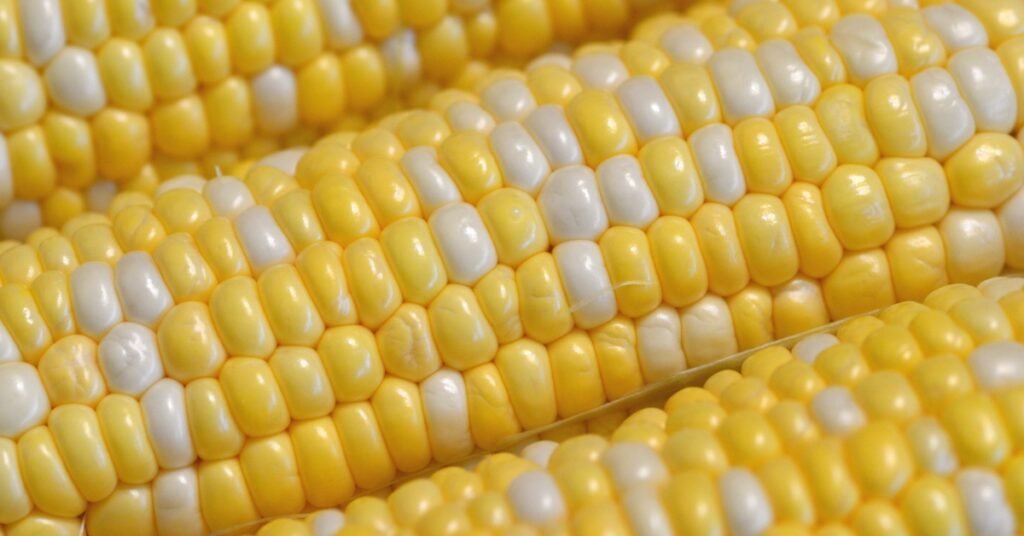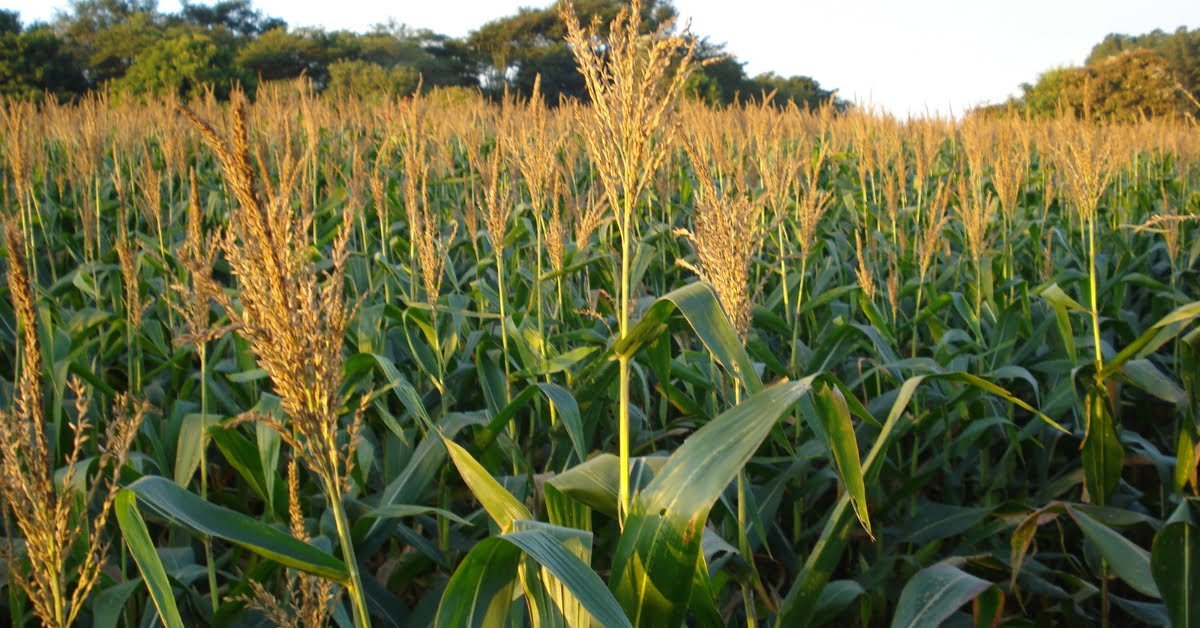Kandy Korn Hybrid Sweet Corn is a yellow, Sugary Enhanced (SE) corn variety that was bred for improved germination and vigor in cool weather. This corn has extra–sweet, tender kernels that retain their sweetness for 3–5 days after picking! A late variety, it grows to be 8‘ tall with beautiful maroon–streaked leaves.A favorite yellow sweet corn that has stood the test of time. Its golden yellow, succulent, 8-in. ears hold at peak quality for up to 2 weeks. The ears are notably tender and juicy with 14-16 full rows of kernels—so you get a mouthful of sweet, juicy goodness with every bite. Kandy Korn Sweet Corn has a nice creamy texture, delicate flavor and good sweet corn flavor. Great for freezing. Looks good in the garden, too. Has pretty, red-hued leaves. Kandy Korn is a sugary-enhanced hybrid (SE) and is known for its superior tenderness, creamy texture and good “corn” flavor. It also has higher sugar levels than (su) varieties and has good holding qualities. When planting, isolate from all (sh2) and (su) corn varieties.
Kandy Korn Sweet Corn (SE)
| Common Names or AKA Names: |
|
| Botanical Name: | Zea Mays |
| Family: | Poaceae |
| Plant Type (Zone 8b): | Annual |
| Hardiness Zones: | Zones 3 through 9 |
| Mature Size: | 7.5′ – 8′ feet tall |
| Native Area: | North America |
| Bloom/Harvest Time: | 83 – 89 Days |
| Sun/Light Exposure: | 8 to 12+ hours of Light. |
| Planting Depth: | 1″ |
| Soil Preferences: | Loamy Soil |
| Soil pH: | 5.8 – 7.0 |
| Aquaponically-Friendly: | YES | USE-CAUTION | LEARN MORE |
| Hydroponically-Friendly: | YES | USE-CAUTION | LEARN MORE |
DESCRIPTION:
Kandy Korn Sweet Corn is a favorite golden yellow sweet corn with attractive burgundy-red tinged husk! The succulent and tender-juicy ears can hold at peak quality for up to 2 weeks. This sugary-enhanced hybrid (EH) is known for its superior tenderness, creamy texture and good “corn” flavor. It also has higher sugar levels than (su) varieties and has excellent holding qualities. Long kernel rows and pretty red-hued husks make an attractive sight in the garden.
Corn is one of the plants grown in the traditional Native American vegetable technique called the Three Sisters. The other two plants in the Three Sisters are beans and squash, and each has its role in the companion planting tradition. Corn serves as a support for the vining beans. Squash served as a ground cover, preventing weeds from growing. Beans provided natural fertilizer for all.
USE:
Sweet corn is the most popular type of corn and it is mainly used for human consumption. It can be eaten fresh, canned, or frozen. Sweet corn is also used to make corn syrup and other sweeteners. It is also used in the production of corn oil, corn starch, animal feed, and fuel. Corn is also used in the manufacture of plastics, resins, adhesives, and textiles. Corn oil is used for cooking and frying food. Corn starch is used as a thickening agent in soups and sauces. Animal feed made from corn is fed to livestock such as cows, pigs, and chickens. Fuel made from corn is used in cars and trucks.
Culture & Cultivation:
For small gardens, sweet corn is best planted in square blocks instead of long rows to improve cross-pollination between corn stalks. Corn will grow best in areas with plenty of sunlight and prefers well-drained soils with a pH between 5.8 and 7.0. To prepare the soil, clear the area of rocks, trash, and large sticks. Small pieces of grass and leaves can be mixed into the soil to make it richer. Sweet corn is best planted after the soil warms and is free from all danger of frost.
- Frequent, shallow cultivation with a hoe or other tool will kill weeds before they become a problem.
- Hoe just deeply enough to cut the weeds off below the surface of the soil. Be careful not to damage the plants when cultivating.
- Once the corn plants have established, they will form a canopy of leaves that can discourage new weeds from growing.
- If you use the herbicide trifluralin (sold as Treflan, Preen and many other trade names) in your vegetable garden, note that you cannot use it near sweet corn.
If you want to learn more about cultivating this specific plant, you might want to check out our online courses where we have plant specific mini courses in addition to our standard fully packed courses and master gardening courses.
Planting & Care:
Zea mays, or corn, is a warm–weather crop that requires cross–pollination in order to produce a good crop. Different varieties of corn have different requirements for the length of the growing season. Sweetcorn, for example, is harvested when the cobs are still maturing and so needs a shorter growing season than a variety grown for its mature, dried seed. Corn requires a warm position and well drained soil in order to grow properly. Ample moisture is also required during the growing season. Corn will not grow well if any of these conditions are not met.
Sow Kandy Korn Hybrid Sweet Corn seeds directly in the garden after all danger of frost is past and soil is warm. Plant 1 seed every 4″. Thin to 1 plant every 12″ when plants are 4″ tall. Control weeds with a mulch and keep plants well watered, especially when the tops begin to tassel.
Small, lightweight Shrunken (sh) kernels demand the most care at planting. Do not plant them deeper than three-fourths to one inch. They will absorb up to twice as much water as other types before they germinate, so keep the seedbed moist until the shoots emerge.
In cooler soil, diseases are more likely to infect seeds. Be sure that your garden soil temperature is at least 65°F. Some gardeners use plastic mulch to speed soil warming.
It is common to husk an ear of sweet corn and find a caterpillar near the tip of the ear, and a chewed-up area of kernels. If this happens in your kitchen, cut the affected part of the ear off with a knife and cook the rest of the ear.
Base your need to manage these pests on their activity in your garden. If you find they are damaging your corn more years than not, anticipate that they will be a problem. If you generally do not see them attacking your corn, you can assume they will not be a problem.
You can avoid problems from these insects by planting corn around early May, and making sure the variety will mature in less than 80 days.
But if you grow later maturing varieties, or if your soil does not warm up early enough to plant in early May, and you have had trouble with either or both of these pests in the past, you will want to take steps to control them.
Diseases:
- Smut causes firm, tumor-like growths on leaves, stems, ears and tassels. Look for smut galls throughout the season and cut them out before they produce spores. Remove these galls from the garden and bury them. Do not compost them.
- Leaf rust appears as rusty orange streaks on leaves that release an abundance of powdery orange spores. Rust resistant varieties are available and are the best form of control.
- Use good cultural control practices to reduce disease problems to a good level and allow for a successful harvest.
Growing new plants can be difficult at times but not to worry Green Grass Grove Academy is here to help! We are excited to offer Online Courses on plant care and other Gardening and Homesteading Courses. Our goal is to provide you with the knowledge and skills necessary to become a successful gardener. Our Online Courses are designed to be self-paced and to be completed at your convenience. Courses contain invaluable information to help you become the ultimate Gardener! In addition, Our Courses have entertaining multimedia, quizzes, and a final exam to test your knowledge. Upon completion of each course, you are eligible to receive a certificate of completion. Some of our most popular courses include Aquaponics/Hydroponics, Plant Pathology, Seeds & Seedlings, Microgreens, Plant Mini-Courses, and Insect Pest & Nutrients Management.
So what are you waiting for? Come on over to Green Grass Grove Academy and let us help you become the ULTIMATE GROWER!
Watering:
- One inch of rainfall per week is good for your corn.
- If your soil is sandy, it is better to water more often than once a week.
- An inch of water will wet a sandy soil to a depth of ten inches, a heavy clay soil to six inches.
- Use a trowel to see how far down the soil is wet. If it is only an inch or two, keep the water running.
- Most garden plants stop active growth when temperatures rise above 85°F, but all types of corn will continue to grow in very hot weather.
- Sweet corn can become drought-stressed in hot dry spells if you do not irrigate it.
- Sweet corn has a shallow rooting depth. Although you will see many new roots developing just above the soil at the base of the plant, these roots do not absorb much water or nutrients. Their function is to stabilize the plant.
Harvesting:
- Harvest ears when kernels in the center of the ear are full and “milky” when squeezed.
- Silks will be drying and browning at harvest time, usually 18 to 24 days after silk first becomes visible. This timing will vary based on weather conditions.
- Depending on genetic type, freshly harvested corn may retain its quality for one to seven or more days in the refrigerator.
- You may can sweet corn only if processed using a pressure canner.
- Freezing is an excellent way to preserve sweet corn.
Aphids | Whiteflies | Scale Insects | Thrips | Caterpillars | Mealybugs | Leafhoppers | Grasshoppers | Earwigs | Snails & Slugs | Spider Mites
Take Our Online Insect Pest Management Course to become an expert at dealing with these pests and others too!
Learn More About This Plant!
- Preparation Ideas: Best used fresh but can be frozen.
- Corn loses flavor and nutrients quickly when left at high temperature.
- For better ear fill, plant a number of short corn rows together instead of a single long row. This helps ensure pollination. For plenty of corn all season, plant both early and late varieties.
- Sugary enhanced has an increased sugar level (30% to 35%), and the kernels are tenderer.
- The sugar is slower to become starch after harvest.
- Fully Sugary Enhanced (se+) types are even sweeter. They will still be sweet after three or more days in the refrigerator.
- Isolate from Shrunken (sh).
The information in this post is NOT medical/nutrition advice, as we are not doctors or nutritionists. This information is for informational/entertainment purposes only and is not a substitute for professional medical advice, nutrition advice, diagnosis or treatment. If you have any concerns or questions about your health or nutrition intake, you should always consult with a doctor or other licensed and qualified healthcare professional.
Green Grass Grove Plant Profiles
No posts found!






